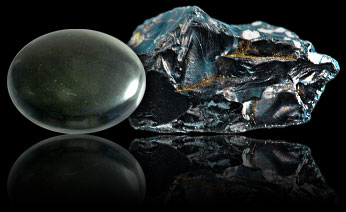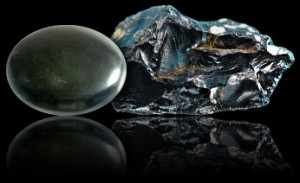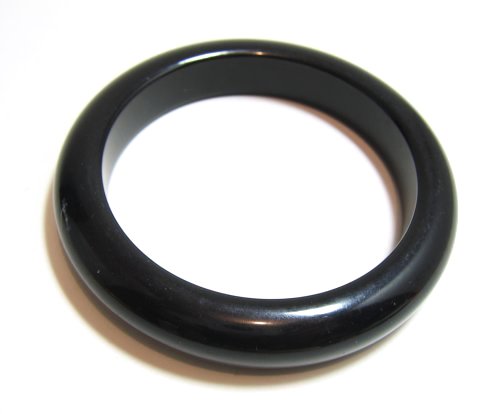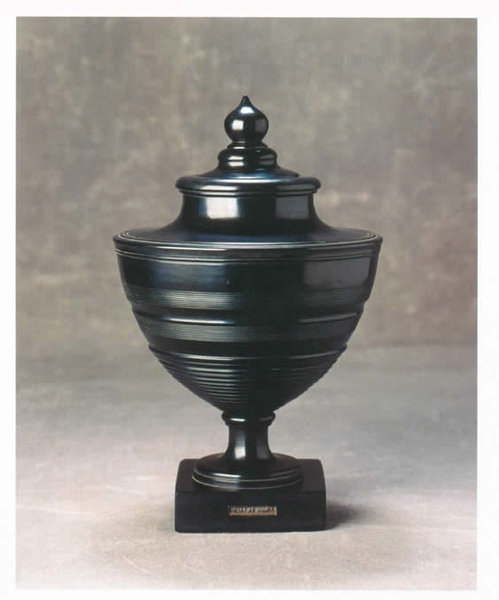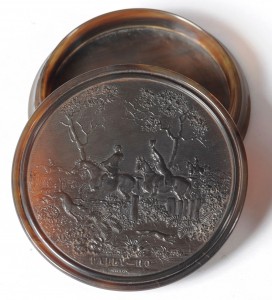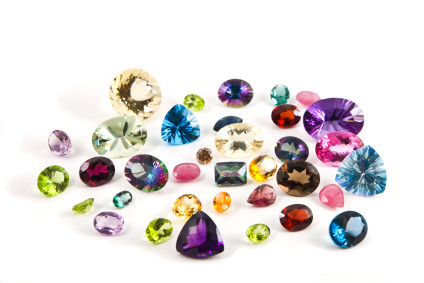Anthracite
Anthracite is found in many places around the world and is a compact and brittle carbon material. Less durable than Jet it polishes well but has not been extensively used for jewellery. Miners were known to fashion small ornaments and carvings from it, mainly as a hobby.
It has a glassy metallic look, distinct from the soft lustre of Jet, and will leave a black mark when rubbed against a piece of fine abrasive paper or unglazed porcelain. If burnt it produces a blue flame and very little smoke.
Bakelite
Bakelite is a phenolic resin, patented in 1909, and was the first truly synthetic plastic material. In weight it is about the same as Jet and it has a deep black colour and can be polished to a good finish. Bakelite was used in the manufacture of brooches, bracelets and beads and can be moulded when heated. It is more durable than jet and can appear too perfect when compared to an antique Jet item with its common collection of chips and small cracks.
When scratched Bakelite produces a black powder. But a more obvious giveaway is that many Bakelite items will be stamped on the reverse with the word ‘patent’.
Bog Oak
This material is a hard black semi-fossilized wood originating from the peat bogs of Ireland. A very popular material with the Victorians it has been used to make items both large and small. When George IV visited Ireland in 1821 he was presented with a walking stick made from the material. Small jewellery items usually have typically Irish designs and decoration. Some later pieces had the designs stamped onto them rather than carved.
Bog Oak is dark brown in colour rather than black and does not polish as well as Jet or some of the other simulants. Often it will have a distinctive peaty smell.
Bois Durci
A material patented in France and consisting of fine sawdust or wood-flour mixed with albumen and stained with lamp black. Used in the limited manufacture of jewellery between 1850 and 1880. The material was not very durable and few items survive.
Cannel Coal
Cannel coal or ‘candle coal’ as it is sometimes known is not as black as Jet and under certain conditions can appear to have a silvery grey sheen. Seldom used for jewellery it was mainly used in the production of small sculptures, ornaments and items such as snuff boxes. Cannel coal will burn more easily than Jet and with less smoke.
Enamel
Black Enamel is sometimes found on brooches, lockets and rings. It is significantly harder than Jet and unlike Jet it cannot be scratched with a pin.
Epoxy Resin
This is the latest plastic to be used in the reproduction of Jet jewellery. Often the reverse side of these items will be slightly concave due to the shrinkage that occurs as the material sets.
When scratched most epoxy resin items give a black powder and when heated the material produces a smell of carbolic.
Glass
Black glass, or ‘French Jet’, is one of the most common materials used to simulate Jet items and was used extensively to produce necklaces. The glass was generally moulded and produced a cheaper alternative to the hand carved and polished Jet.
A limited amount of black glass jewellery was also produced in England where it was known as Vauxhall glass. When held to the to the light it has a slightly reddish or purplish tinge as a result of being coloured with manganese oxide.
Black glass is easy to tell apart from Jet as it is heavier and colder to the touch. It also has a bright shine and hard appearance, unless it has been intentionally dulled or ‘bloomed’.
Horn
Horn is light and can be easily worked, even moulded if heated in water. When stained it can be passed off as Jet but items are often rough and scaly on the reverse side.
Horn does not have the deep glossy black of Jet and when held up to the light the edges are often translucent due to incomplete staining. When scratched the material produces a grey powder. When a hot needle is applied the material will smell of burning hair.
Lignite
Lignite is another form of coal deposit that is not as dense as Jet. In Germany its use predates that of Jet, whilst in Britain it can be found alongside Jet in the remains of Roman settlements.
Few items have survived the centuries without cracking or breaking up and it was little used after Roman times.
Quartz
Onyx and Chalcedony are two forms of quartz that occur in black, or can be stained black. Onyx was frequently used by the Victorians for Jewellery items but like black glass it is easy to distinguish from Jet by its weight and cold feel.
Shale
Kimmeridge shale is a bituminous shale found in Dorset in the south of England. In its natural state it has the appearance of slate. It is light and ranges in colour from grey-black to brownish-black.
When polished it looks very similar to Jet but tends not to retain its lustre over time and items often crack or break due to the gradual loss of its natural oil content. The material was used from the Iron Age to the end of the Roman occupation.
Vulcanite
In 1846 a patent was taken out for a material made by mixing rubber with sulphur and then heating it to 115 degrees C. The resulting hard material known as Vulcanite or Ebonite turned out to be the most successful simulant of Jet.
It was light, black, could be polished and like glass could be moulded to mass produce items quickly and cheaply. Items such a brooches, pendants and chains were all made from the material and often Jet and Vulcanite items can be found in near identical designs.
Like Jet, Vulcanite produces a brown powder when scratched. It does give off a faint sulphur smell but this is almost impossible to detect. Vulcanite is more durable than Jet and therefore unlikely to chip or crack. As with Bakelite this can be an indicator that the item is not a genuine antique Jet piece.
When Vulcanite is directly compared with genuine Jet it appears less black. If the material has been exposed to light for long periods then the item will usually have faded to brown. When burnt it gives off a strong smell of burning rubber.
Wood
Some cheap jewellery was made using dark woods such as ebony or by staining lighter woods or painting them with black enamel paint. On older items the finish is likely to be scratched or worn, revealing the natural wood beneath.
Jet: Proper Use and Identification
While a number of jewelry materials can be described as, “Black as jet”, the word ‘jet’ should only be used to describe an item of jewelry which is made from the organic material identified as ‘jet’ to avoid any possible confusion on the part of the buying public.
Jet is one of the oldest materials used in making jewelry. Bronze age tombs have been unearthed that contained jet ornaments and jewelry. The Roman occupation and Viking conquests of Britain saw to it that the material was widely distributed. The Whitby area, near York, is the best-known source for jet in the world.
Jet is an organic material or mineraloid – a fossilized form of vegetation. Due to is high carbon content it is classified as coal. Some sources believe jet is a lignite coal, but others disagree asserting jet to be a fossilized by product of the decomposition of a particular species of tree, the Araucaria. While used since ancient times for ornaments and jewelry, it reached its height of popularity during the Victorian era. The majority of 19th century jet jewelry was produced in Whitby in Yorkshire, England. The Whitby jet industry showcased its products at the Crystal Palace exhibition in 1851, securing a place in the fashion world for this unusual material. With the death of Prince Albert in 1861, and the subsequent popularity of mourning jewelry and requisite black color insured that jet would be quite fashionable for years to come. Jet is lightweight making it an excellent choice for the very large jewelry designs that were in-style at the time. Jet is also easy to carve and because it can be turned on a lathe, it was an ideal material for bead production.
SIMILAR MATERIALS
There are a number of materials, which are easily confused with jet, many of which saw widespread use during this time period. Bog oak exhibits many of the same qualities as jet, thus giving is a similar appearance to jet, and is actually a related material. As vegetable matter decomposes, it becomes peat, a material that is required to create the conditions necessary to preserve (petrify) large trees to produce bogwood. The heat and pressure of several million more years is needed for the material to change into the coal known as jet. Bog oak pieces can be carved like jet, or molded.
Gutta-percha and vulcanite are two man-made materials, which were also used to simulate jet, offering buyers a cheap alternative to genuine jet. Gutta-percha is a rubbery substance derived from the latex material of several varieties of tropical trees. Vulcanite is hard rubber produced by a process called vulcanization. Both materials are molded and never cut like jet. Items made from jet have sharper details than items produced from gutta-percha or vulcanite.
‘French Jet’ or black glass is another material sometimes misidentified as jet. Black glass is much heaver than jet, has a cold feel and during the Victorian period was used primarily for the necklaces. Opaque black minerals like chalcedony (black onyx) and organics such as black coral can also be mistaken for jet, although they too are heavy and cold to the touch. Dyed horn is another material that can be misleading.
CHARACTERISTICS AND TESTS
True jet is lightweight. Finished pieces characteristically have sharp precise cuts. If subjected to a hot point (though not recommended) it will give off an oily or coal like odor. When rubbed with wool it will develop an electrical charge, similar to amber. The most definitive test is its streak. When rubbed against an abrasive surface, it will leave a brown streak. This is also a somewhat destructive test, which must be used with great caution. There are no known enhancements of jet.
Gutta-percha will give off a burnt rubber smell when rubbed briskly. It and vulcanite will give off the same smell when subjected to a hot point test. Vulcanite may also have a sulfurous smell, as sulfur is one of the materials used in its production. Horn products will give off the smell of burnt hair when subjected to a hot point, and sometimes when rubbed briskly.
Please note that the hot point test, along with streak testing, can be destructive tests. Extreme caution must be used to avoid damage to the pieces being tested.
Jet will warm to the touch quicker than black glass (French Jet), and both materials will warm to the touch quicker than a mineral like chalcedony.
New jet jewelry pieces are still being produced, but its last extensive use was during the 1920’s and 30’s as beads for “flapper” jewelry.
While almost synonymous with the word black, great care must be used when using the term jet as a color description. A buyer might expect those “Jet Black Beads” to actually be made of jet. If you really feel the overwhelming need to use the term ‘jet’ as a color description, please take the extra time to make sure your meaning and description are clear, by using phrases like “Jet Black Colored Glass Beads”. Similarly, it should be made clear that “French Jet” pieces are “French Jet Glass”. The best way to avoid confusion is to only use the word ‘jet’ when describing the organic material for which Whitby England is famous.
Credit: http://blog.rubylane.com/

